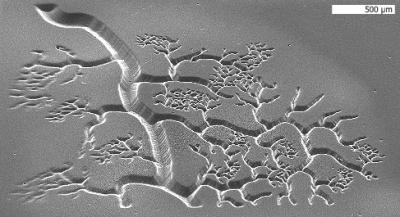An innovative technique to fabricate three-dimensional microstructures from soft and biocompatible hydrogel in a span of few seconds has been conceived by nanoengineers at the University of California in San Diego.
 3D Printing of Blood Vessels on Soft, Biocompatible Hydrogels (Credit: Biomedical Nanotechnology Laboratory, Chen Research Group, UC San Diego Jacobs School of Engineering)
3D Printing of Blood Vessels on Soft, Biocompatible Hydrogels (Credit: Biomedical Nanotechnology Laboratory, Chen Research Group, UC San Diego Jacobs School of Engineering)
The new biofabrication technique is labeled dynamic optical projection stereo lithography (DOPsL). The immediate application of the technique could be in the growth and study of cells, especially stem cells in labs. The futuristic goal in the development of this technique is to acquire the capability of biological tissue printing for use in regenerative medicine.
Nanoengineering professor Shaochen Chen developed the DOPsL technique in his lab. Micro-contact printing and photolithography are existing fabrication techniques which can only produce two-dimensional structures and simple geometries. Another technique that can print three-dimensional structures called stereo lithography is best suited for large objects such as car parts and tools.
According to Chen, the key aspect of micro level biofabrication is the nano and micro level resolution needed to fabricate tissues replicating natural ones down to the granular details, especially the blood vessels which are vital for oxygen and nutrient distribution in the body. An engineered biomaterial sans the blood vessels is not of much use. By using the DOPsL technology, Chen and his team were able to demonstrate the fabrication of complex structures like spirals, flowers and hemispheres. The advantage of this technique over other three-dimensional fabrication techniques like two-photon photopolymerization which take hours to fabricate is the ability to print in few seconds.
The DOPsL technology is being developed on the strength of a US $1.5 million grant over a four-year period from the National Institute of Health.